
About UsThe Numismatic Bibliomania Society is a non-profit organization promoting numismatic literature. For more information please see our web site at coinbooks.org SubscriptionsThose wishing to become new E-Sylum subscribers (or wishing to Unsubscribe) can go to the following web page link MembershipThere is a membership application available on the web site Membership Application To join, print the application and return it with your check to the address printed on the application. Membership is only $15 to addresses in the U.S., $20 for First Class mail, and $25 elsewhere. For those without web access, write to: David M. Sundman, Secretary/TreasurerNumismatic Bibliomania
Society AsylumFor Asylum mailing address changes and other membership questions, contact David at this email address: dsundman@LittletonCoin.com SubmissionsTo submit items for publication in The E-Sylum, just Reply to this message, or write to the Editor at this address: whomren@coinlibrary.com
BUY THE BOOK BEFORE THE COINYou won't regret it! |
- WAYNE'S WORDS: THE E-SYLUM APRIL 3, 2011
- NUMISMATIC BOOKS, AUTHORS AT CHICAGO INTERNATIONAL COIN FAIR
- LAKE BOOKS SALE #107 CLOSES APRIL 26, 2011
- NEW BOOK: THE AUTHORITATIVE REFERENCE ON TWO CENT COINS
- BOOK REVIEW: BRITISH COMMEMORATIVE MEDALS AND THEIR VALUES, 2ND EDITION
- LEN HARSEL, C1940-2011
- STEVE TANENBAUM TRIBUTE WEB SITE
- MORE ON COIN DEALER FRANK DUPEE
- THE ASHMOLEAN MUSEUM COIN GALLERY
- QUERY: COMMUNION TOKEN ATTRIBUTION SYSTEMS
- NEW NAME TREND: COIN TRAIL
- MORE ON THE FRANKLIN MINT COLLECTOR'S SOCIETY
- FINDING 'MR. 880': THE CASE OF THE ONE-DOLLAR COUNTERFEITER
- BAN THE BENJAMINS!
- NOTES FROM E-SYLUM READERS: APRIL 3, 2011
- THOUGHTS ON THE SAN FRANCISCO MINT GOLD DELIVERY BOOK
- WAYNE'S NUMISMATIC DIARY: APRIL 1, 2011
- DO THESE LEAD CODICES HAVE A NUMISMATIC CONNECTION?
- HOW THE INTERNET HAS CHANGED RARE COIN AUCTIONS
- BIRMINGHAM MINT RELOCATES
- MOVIE LAWYER DISCUSSES PROP CURRENCY
- HOW THE BRAIN RESPONDS TO THE DESTRUCTION OF MONEY
- SCRAPPED EURO COIN SMUGGLING RING FOILED IN GERMANY
- FEATURED WEB PAGE: 1792 HALF DISME DUG UP IN VIRGINIA
WAYNE'S WORDS: THE E-SYLUM APRIL 3, 2011

Among our new subscribers this week are Walther Ellis and Robert Huffman. Welcome aboard! We now have 1,410 email subscribers, plus 129 followers on Facebook, including Timothy Cook and the Sociedad Numismática de Bolivia.
Sorry about the Subject line in last week's issue - that was due to my haste in catching up from my computer crash. Without "The E-Sylum" in the subject line, the mailing went into at least one reader's Junk box.
We're pretty much back on track now, but I have a very limited email address book now. If you've emailed me recently and didn't get a reply or see your submission in a recent issue, please write again. I can be reached at whomren@gmail.com.
This week we open with items about numismatic literature at the upcoming Chicago International Coin Fair, Fred Lake's next sale, and a new book. Next, we have a review of Christopher Eimer's new book on British medals, and word of the loss of another numismatic personality.
Other topics include the Ashmolean Museum numismatic collection, the Birmingham Mnt, movie prop money, and an unusual counterfeiter. To learn more about "Mr. 880", Scottish Communion token references, coin trail publicity stunts, and how the Internet has changed rare coin auctions, read on. Have a great week, everyone!
Wayne Homren
Numismatic Bibliomania Society
NUMISMATIC BOOKS, AUTHORS AT CHICAGO INTERNATIONAL COIN FAIR
 The 36th annual Chicago International Coin Fair is set for April 14-17 at the Crowne Plaza O'Hare in Rosemont, Ill., and there will be plenty of people and items of numismatic literary interest at the show.
The 36th annual Chicago International Coin Fair is set for April 14-17 at the Crowne Plaza O'Hare in Rosemont, Ill., and there will be plenty of people and items of numismatic literary interest at the show.
Leading booksellers John H. Burns of North Huntingdon, Pa., and Northern Illinois Coin & Stamp of Mt. Morris, Ill., will be in attendance with a wide variety of coin books for sale. N. Douglas Nicol, who led Krause Publications' efforts compiling the recently-released Standard Catalog of German Coins, Third Edition, will speak to the Everycountry Collectors Group at 8 a.m. April 15, and will be at the KP table to discuss the book. KP market analyst Tom Michael and editor George Cuhaj, who produce the Standard Catalog of World Coins series, will be there, along with U.S. Coin Digest and North American Coins & Prices editor Dave Harper.
Wayne G. Sayles, author of KP's Ancient Coin Collecting series of books, will give an update on behalf of the Ancient Coin Collectors Guild and man The Celator table with Kerry Wetterstrom. Allen G. Berman, who has authored a variety of coin books for KP, will have a table on the bourse, and will be hosting his regular Bermanian Guild of Numismatists gathering. Harlan J. Berk, author of 100 Greatest Ancient Coins, will have an extensive presence on the bourse floor, and will be working with Heritage on an ancient coin auction session. Robert D. Leonard, author of Curious Currency, will be at the American Numismatic Society table.
For more information on the CICF bourse, world and ancients auction from Heritage and Gemini, and club meetings and programs, visit www.cicfshow.com .
LAKE BOOKS SALE #107 CLOSES APRIL 26, 2011
Lake Books announces that its mail-bid sale of numismatic literature #107 is now available for viewing on their web site at http://www.lakebooks.com/current.html
The sale features Part Two of selections from the library of Eric von Klinger. The 501-lot catalog contains a large number of works on American material plus many reference books on Ancient and European coinage. In addition, you will find books on Paper Money, Tokens and Medals and other items of interest.
Closing date for the sale is Tuesday, April 26, 2011 at 5:00 PM(EDT) and bids may be sent via US Mail, e-mail, fax or telephone until that time.
We are always interested in helping you dispose of your duplicate material or reference books that you are no longer using. Please contact us for more information.
Cordially, Fred
Lake Books
6822 22nd Ave. N.
St. Petersburg, FL 33710
727-343-8055 Fax 727-345-3750
NEW BOOK: THE AUTHORITATIVE REFERENCE ON TWO CENT COINS
The book titled "The Authoritative Reference on Two Cent Coins" by Kevin Flynn should be going to print the second week in April and ready mid-May. The book is 8-1/2 * 11, 222 pages and tons of photos.
This is Flynn's 39th book on numismatics. Flynn's favorite coin series and his first book in 1994 was on Two cent coins. This series has an incredible number if die varieties, some of the more dramatic for any 19th century series. It also is rich in history and hot topics.
The primary purpose of this book was to create a complete and comprehensive reference for the Two cent series including all major die varieties, history, hub changes, collecting, historical documents, and hot topic such as the proofs and an analysis of each of the overdates which were listed for this series..
The die variety section of the book includes a complete listing of the known doubled dies, misplaced dates, repunched dates, off-denomination clashes, off-design clashes, and off-center clashes, including several new die varieties which have not been listed before. For each die variety listed, detailed macro photos make identification much easier. Most of the varieties include multiple photographs showing different details. Included also for each variety is a detailed description of the variety, diagnostics, including die markers such as die cracks, scratches, clashes which can make identifying the variety easier, pricing, and cross references.
Many new archive letters were uncovered relative to the Two cent series and are included. This greatly helped in the analysis of the history section and shed new details on the series. For each hub change, enlarged photos show the before and after of the design changes with a detailed description of the differences. Also included is a section shows the different date punches used.
The date-by-date section offers an analysis of each date including scarcity, striking characteristics, world history which occurred that year, hot topics, comments, current values, prices realized from Heritage Auctions, and the certified population counts from PCGS and NGC.
The Hot Topics section contains a several detailed studies on the Two cent series including an analysis of all of the alleged Two cent overdates, 1865 Fancy / Plain repunched date, 1864 Small Motto proof, 1864 Small Motto business strikes, 1871 proof, a complete analysis Two cent proof counts, 1868 – 1873 common proof reverse, Two cent restrikes, and the number of Two cents redeemed and melted.
I am doing the final updates now.
Printing both hardcovers and softcovers.
Retail will be
Hardcover $100 (only printing about 60)
Softcover $39.95
Shipping is $5 for book rate, $10 for priority.
Prepublication pricing will be available till the book is printed
Prepublication prices are
Hardcover $85
Softcover $33
Need to include shipping, $5 for book rate, $10 for priority
Please send a check or money order to
Kevin Flynn
P.O. Box 396
Lumberton, NJ 08048
I am currently working on a book on the top Liberty Seated die varieties, which should be finished in May. If you have Liberty Seated die varieties, please write me at the above address.
I am also working on the second and third kids books, the second is Coins in the Classroom, the third is Helping Kids Starting to Collect.
For a complete list of books I have written, check out www.kevinjflynn.com
BOOK REVIEW: BRITISH COMMEMORATIVE MEDALS AND THEIR VALUES, 2ND EDITION
British Commemorative Medals and Their Values
by Christopher Eimer (by John W. Adams)
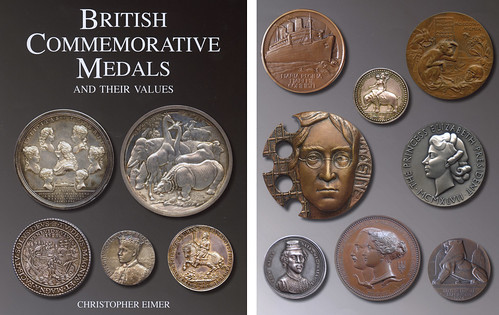
An earlier version of this book was published in 1986. In 1905, Mr. Eimer set about a simple revision, intending to update the values and be done with it. However, having done that and made a few additions, it become apparent that the corpus needed to be expanded, to include the last 25 years. Once having done that, it became apparent that the earlier images were relatively shabby and hence needed complete replacement. What was designed to be a one year project had, in the end, become a five year project. However, the final result is a brand new book, one that is an instant classic.
Mr. Eimer succeeds in classifying 2230 medals; the first issued in 1087 and last almost a millennium later in 2010. Each description, though necessarily brief, is thorough, containing pertinent information on date of issue, subject, legend (obverse and reverse), engraver, diameter, series classification and value by both condition and metal. The end result is truly encyclopedic.
The word "Encyclopedic" suggests that the content of the book is dry and boring. Such is hardly the case. To make the point, we equate from the description of Eimer 770, "Charles Genevieve Louis Auguste André Timothée De Beaumont D'Éon (1782-1810). French ambassador, courtier, and a transvestite of considerable renown. In 1777 a civil court action was fought by two men in respect of a wager concerning D'Éon's gender, which had aroused much curiosity and financial speculation during the time he was in London. The affair was a minor cause célebre and only entirely resolved on his death. See London Magazine (September, 1777)."
Such pithy background is enhanced by the author's deep knowledge of the subject matter. Mr. Eimer suggests that the D'Éon medal is linked to the Hume medal of 1776 and the Franklin (wearing a cap) medal of 1777. Thus, if the D'Éon medal was made in England—and where else would it have been made?—then the 1777 Franklin medal was made in England, a treasonous act given the war going on at the time.
The book contains nearly 100 pages of images in high resolution (for the most part) color.
As if 2230 listings were not more than any mortal can digest, the author adds a panoply of supporting sections. These include a bibliography, a concordance with the 1987 work, an index of medalists (the best such we have seen), a listing of medallists abbreviations, a listing of the sources of the illustrations and an excellent general index. Altogether, these sections make the book easier to use and/or provide nuances for advanced students.
The reason to buy the book is that not owning is a deprivation.
To read the earlier E-Sylum book announcement, see: NEW EDITION: BRITISH COMMEMORATIVE MEDALS AND THEIR VALUES (www.coinbooks.org/esylum_v13n49a05.html)
MILLIONS OF COIN COLLECTORS CAN'T BE WRONG!
LEN HARSEL, C1940-2011
Howard A. Daniel III writes:
Len Harsel passed on March 26 in Venice, Florida at his winter home. He was a retired US Army Lieutenant Colonel with two tours in Vietnam and several in Europe. During his overseas tours he became interested in world coins and paper money and started to collect them. After the Army, he started selling his duplicates at local coin shows and mailing out a price list. At some point, he stopped collecting and became a full time dealer in world paper money. He was a regular fixture at the quarterly Vienna (Virginia) Coin and Stamp Show with his usual table in one of the corners of the bourse. He also was a regular at the Baltimore shows and setting up with David Gotkin, who would assist him in getting his stock to the tables. I used to drive him to the Memphis International Paper Money Show but in the past few years, his health prevented him from taking long journeys to shows.
His wife, Sue, has told me there will be a Memorial/Celebration of Life service for him at Fairfax Memorial Funeral Home at 9902 Braddock Road, Fairfax, VA 22032 on April 9 but his burial at Arlington National Cemetery will be at least a couple of months later. There is a large backlog of burials at Arlington due to the current wars and many WWII and Korean veterans are passing away. Sue can be contacted at SueHarsel@aol.com.
Len made prior arrangements with Daryl Spelbring to have him to sell off his inventory, and I will likely take care of his library. If you are interested in Len's world paper money, please contact Daryl at P.O. Box 633, Vienna, VA 22163-0633 or hottub4@aol.com. If you are interested in old coin and paper money catalogs, please contact me at P.O. Box 626, Dunn Loring, VA 22027-0626 or at HADaniel3@msn.com.
STEVE TANENBAUM TRIBUTE WEB SITE
 Steve's major hobby as a child was, unsurprisingly, numismatics and from an early age he had an entrepreneurial bent. His brother Andy remembers, "One time when he was about 10, he asked our father to loan him $100, which he did. He then went to a local bank and asked for 2000 nickels, which the bank gave him. He tediously went through all 2000 nickels looking for rare or interesting ones. He might have found 4 or 5, perhaps a dozen at most. He then replaced these with ordinary, boring nickels, went back to the bank, and asked for 1000 dimes.
Steve's major hobby as a child was, unsurprisingly, numismatics and from an early age he had an entrepreneurial bent. His brother Andy remembers, "One time when he was about 10, he asked our father to loan him $100, which he did. He then went to a local bank and asked for 2000 nickels, which the bank gave him. He tediously went through all 2000 nickels looking for rare or interesting ones. He might have found 4 or 5, perhaps a dozen at most. He then replaced these with ordinary, boring nickels, went back to the bank, and asked for 1000 dimes.
Similarly, he went through the dimes one at a time and replaced a few worthwhile specimens with more garden-variety dimes. When he brought these back to the bank, he asked for and got 400 quarters, which he also processed one at a time. When he was all done, he got his $100 back. Well, let's just say there are a lot of banks in White Plains." Steve's love of numismatics was evident even at the age of ten.
In 1978, he formed a partnership with Richard Rossa, known in the trade as RAT (Rossa And Tanenbaum), with an elegant rat playing a piano as their company logo. Steve eventually moved to Brooklyn, NY, where he lived for the rest of his life.
Steve was especially interested in exonumia, the branch of numismatics that deals with items other than coins and paper money. His real love was Civil War tokens which were produced by stores during the civil war when there were few coins in circulation, the metal having been melted down for military purposes. Each token (similar to a coin though technically different) thus belongs to a particular store and was issued and used during a fairly short time span. RAT was a dealer in these and other antique collectibles.
Steve was extremely modest and never spoke of his many accomplishment in the field of numismatics. He was elected eight times to the Board of Governors of the Civil War Token Society and was recognized by his peers as one of the most knowledgeable people in the country in the area of Civil War tokens. Working with collectors, he helped build many of the great modern collections.
MORE ON COIN DEALER FRANK DUPEE
Web site visitor Ray Poincelot writes:
I wondered whatever happened to Dupee's coin shop owner, so I found the NBS site. The story brought back many memories. I collected coins in high school and went to Dupee's place many times. I'm pretty sure he was there in 1959, as that was freshman year in High School in West haven CT. I recall taking the bus there from 1959 to about 1961. Frank was a kindly man and helpful to novice coin collectors with not a lot of money to spend. Thanks for reviving the memory.

To read the earlier E-Sylum article, see: FRANK DUPEE FOUND IN NEW HAVEN, CONNECTICUT (www.coinbooks.org/esylum_v13n17a14.html)
THE ASHMOLEAN MUSEUM COIN GALLERY
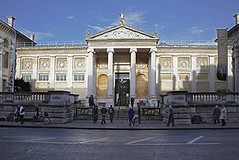 One object next to the other, some curators still think, that's the art of museology. And they are very surprised, when visitors admit that they found their tour a little bit boring. We need new conceptions to mesmerize traditional and new visitors. The renovated Ashmolean shows how to do it.
One object next to the other, some curators still think, that's the art of museology. And they are very surprised, when visitors admit that they found their tour a little bit boring. We need new conceptions to mesmerize traditional and new visitors. The renovated Ashmolean shows how to do it.
Only the classical entrance of the building accomplished in 1845 was conserved. Between 2006 and 2009 the showrooms and all facilities for administration and scholarship were rebuilt.
The galleries are more than a place for objects, they want to communicate a message. The Islamic gallery for example addresses an art without pictures. The coins are used here in order to trace the development of this art: away from the Byzantine patterns to purely abstract artworks.

The Ashmolean Money Gallery
The Money Gallery features the highlights of the Ashmolean coin collection, including a hoard found in 2003, which enclosed an antoninianus. This coin proved the existence of Domitianus, a Late Roman emperor reigning ca. 271.
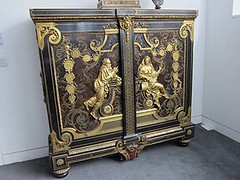
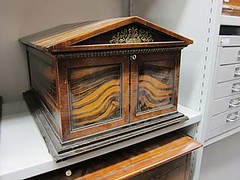
Coin Cabinets in the Ashmolean Money Gallery Strong Room
The Ashmolean is more than a tourist attraction. Here, young archaeologists, historians and numismatists are trained. This room is the place for numismatic studies. It is located next to the strong room, where the extensive coin collection is stored under conservationally ideal conditions.
I guess Elias Ashmole would have been very happy, if he was able to see, how "his" museum was adapted to the needs of the 21st century!
To read the complete article, see: The new Ashmolean and its astonishing conception (www.coinsweekly.com/en/News/4?&id=512)
THE BOOK BAZARRE
QUERY: COMMUNION TOKEN ATTRIBUTION SYSTEMS
Guy Coffee writes:
I noted with interest that a few issues back you wrote something or asked about websites on communion tokens. I have a question to put to your readers about Scottish Communion tokens. If you'll check at the following website http://www.civilwartokens.com/communion_tokens.html there will be a chart displayed. It's the title of the very two first columns that is of interest to me. Can someone define what is meant by Burz# and Cres# ?
In anticipation of reading an answer to my questions, I kindly thank those who are able to answer.
Lester Burzinski. Communion Tokens of the World. 1999.
O. D. Cresswell. Comprehensive Directory of World Communion Tokens. 1985.
-Editor
To visit the web page, see: Communion Tokens (www.civilwartokens.com/communion_tokens.htm)
NEW NAME TREND: COIN TRAIL
 Mark my words. This is a trend that will catch on all over the world! School children are asked to help raise funds for some worthwhile cause. Families contribute a handful of coins. The kids bring the coins to school. But then what?
Mark my words. This is a trend that will catch on all over the world! School children are asked to help raise funds for some worthwhile cause. Families contribute a handful of coins. The kids bring the coins to school. But then what?
Most dump the coins in some container requiring someone to count, or cart them off to a coin counting machine, like Coinstar. Sometimes different classes have a competition as to who can contribute the highest amount.
But a primary school in Sheepscombe England is the first I know to use the term "Coin Trail" to form a path of coins laid out in a straight line. I wish I had thought of that term "Coin Trail." Excellent! I can see a competition among classes for the longest line.
Here in the Colonies we have a different name for it -- "Coin Laying." And we have made some long lines: 40 miles by a group in Kansas, and 65 miles for a group in California in 2009. The California group obviously displaced the Kansans in Guinness Book of World Records. Kinda makes those British kids pikers.
I mentioned this in the December 13, 2009 E-Sylum (vol 12, no 13, art 13). I tried to promote this stunt to my boss at Medallic Art one time. We made medals for the Danbury Fair two miles away. I wanted to lay medals from our front door to the Fair gates as a publicity stunt. I got a blistering memo back that should have been printed on asbestos. You will have to click on that in the E-Sylum archive to read it. I am still smarting from that reprimand 41 years ago!
Meanwhile, click on this story of those darling little kids in England:
www.stroudnewsandjournal.co.uk/news/8948340.
Pupils_create_a_coin_trail_to_raise_funds/
Note for future school administrators: Get long strips of cloth. Have the kids lay the coins on the cloth. It is a massive chore to pick up coins afterwards without it.
MORE ON THE FRANKLIN MINT COLLECTOR'S SOCIETY
Ken Potter writes:
Regarding the Franklin Mint Collector's Society, I joined to buy a set of ingots wanted and wish I still had (one of the few items that was of topical interest to me). I was not afforded all the "extras" you speak of but did take a tour or the Franklin Mint in around 1973. I collect the cruise ship medals they made for folks that took the cruses and am only missing the Mexican one. I passed on it in a shop not recognizing what it was and when I went back it was gone.
Beyond that I remember little but do have a rare FM Dealer's manual that each dealer that ran a FM store got a copy of. Maybe 50 copies were made (just a guess) figuring they couldn't have had more than one store in each state.
Mine probably came from the Fairlane Shopping Mall FM store in Dearborn, MI. It contains far more information about the engravers, etc., than the literature given to the public. It is in a blue three ring binder and maybe 3" thick and printed on very heavy card stock (maybe 60 pound or better stock). It is a great reference to have when I write my column for Krause's World Coin News and a coin was made by FM and I want to know more about it.
Ken Bressett writes:
I will respond to Len Augsburger's request for information about the Franklin Mint Collectors Society because I suspect that very few of the original members of the group are still around, or would be willing to break their vow of secrecy.
This was an elite group that was given many special privileges including the opportunity to acquire off-metal striking of many medals, patterns, trial pieces and other goodies. Some of these were given as largess, others at minimal cost. Such things could often be requested as ‘special strikes' if ordered in advance of minting.
Members were often consulted as to what designs or themes were wanted, or what they thought the public would be willing to buy. You could submit a rough design concept and have a Franklin Mint artist prepare plasters. If the group approved, it would be made into a medal.
The Society Club Room was at the Franklin Mint. It was for the member's exclusive use for meetings, discussions about designs, plans for new medals, etc. It was beautifully appointed with a wall full of original plasters, design art work, galvanos, and models. Delicious treats were always present, and the bar was well stocked with everything from Champaign to Saki.
In adjoining rooms there was assistance for correspondence or related business, or for making travel arrangements which were fully paid for by the Franklin Mint. The full array of current products was always on display and available at reduced prices for members. Their numismatic library of over 20,000 books was available for use there or items could be borrowed for up to three weeks.
It was a great Society but unfortunately could be used only one day each year on
April 1.
To read the earlier E-Sylum article, see: QUERY: FRANKLIN MINT COLLECTORS SOCIETY CLUB ROOM (www.coinbooks.org/esylum_v14n13a07.html)
FINDING 'MR. 880': THE CASE OF THE ONE-DOLLAR COUNTERFEITER
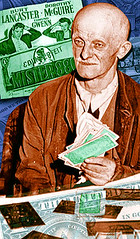 Clearly, no criminal mastermind had produced this dollar. It was printed on a piece of cheap paper, available at stationery stories all over. At best, the artwork was crude, childish even. A black splotch served as Washington's left eye, his right was almond shaped. Letters and numbers were poorly formed, illegible, or uneven.
Clearly, no criminal mastermind had produced this dollar. It was printed on a piece of cheap paper, available at stationery stories all over. At best, the artwork was crude, childish even. A black splotch served as Washington's left eye, his right was almond shaped. Letters and numbers were poorly formed, illegible, or uneven.
But in November 1938, the owner of a Broadway cigar store accepted it without a second glance. After all, even in the depths of the Depression, what shopkeeper could take the time to scrutinize a one-dollar bill?
The storekeeper didn't realize he'd been had until he went to the bank and the teller pointed out the obvious irregularities on this particular slip of paper.
Crude it may have been, but the bogus buck was soon getting sniffed over by the watchdogs of America's money supply, the Secret Service.
But whoever slapped this new bill together was not in their league. In fact, no self-respecting counterfeiter would even bother with so small a sum. It was not worth the effort.
Nevertheless, a fake is a fake, so the Secret Service dutifully opened a file, No. 880, put a New York City map on the office wall and, with a red thumbtack, marked the spot where the bill was passed.
Year after year, hundreds of red tacks went up on the map. Merchants continued to take the bill, even though the already shoddy work deteriorated over the years.
In addition to the fanciful artwork, one batch of bills featured an unbelievable typo - "Wahsington."
Still, the dollars kept coming; nearly $5,000 worth would eventually pile up. They were all single dollars, and had been passed at local businesses - groceries, newspaper stands and bars.
The Secret Service threw everything they had at finding the culprit, with no luck. America emerged from the Depression, then fought and won the second World War, but still there was no break in the case of "Old Mr. 880."
The tale caught the eye of St. Clair McKelway, a staff writer for the "New Yorker." McKelway's articles piqued the interest of Hollywood, and in 1950, Juettner's story came to the big screen. "Mr. 880" starred Burt Lancaster, playing the Secret Service agent. The role of the quirky counterfeiter went to none other than the actor beloved for his portrayal of Kris Kringle in "Miracle on 34th Street," Edmund Gwenn.
After his brush with the law, Juettner went clean. When asked to explain why he was giving up counterfeiting, he said simply, "There isn't enough money in it."
To read the complete article, see:
Finding 'Mr. 880': The case of the $1 counterfeit
(www.nydailynews.com/news/ny_crime/2011/04/03/2011-04-03_
finding_mr_880_the_case_of_the_1_counterfeit.html)
BAN THE BENJAMINS!
This is a $100 bill. It's the currency of criminals, kleptocrats, and sociopaths.
Other people may use it, but nobody else needs it. ATMs almost never stock it.
Why does the U.S. Treasury continue to print it?
In this age of credit cards and debit cards, you don't see a lot of C-notes in America. But foreigners love it. Sixty-five percent of all C-notes are held by foreigners overseas.
Now usually foreigners don't stash greenbacks under their mattresses. Paper bills don't generate interest! Foreigners want bank deposits, which do generate interest, and Treasury notes, which generate more interest, and maybe even some real estate or stock in U.S.-based corporations, which have the potential to create more wealth still.
Some foreigners, though, would prefer to hang onto paper dollars, because - shhh! - they don't want anybody to know they have American bucks.
Occasionally their motives aren't dishonest. If you live in a corrupt country that's likely to seize your wealth, you might have good reason to hide your C-notes from the authorities.
But most foreign Benjamins, it seems a fair guess, are in the hands of not-very-nice people. Dictators, drug lords, warlords, oligarchs, terrorists.
So why do we keep printing $100 bills?
Well, if the C-note ceased to be available to foreign criminals and dictators, another paper currency would have to take its place. The leading candidate would be the 500 euro note. For its admirable compactness, criminals have nicknamed it "the Bin Laden." Indeed, should the U.S. stop making $100 bills, the Bin Laden could easily become the preferred currency of America's criminal class.
But surely, if we banned our Benjamins, the Europeans could be shamed into banning their Bin Ladens. They don't want to help criminals and terrorists any more than we do.
It's happened before: Back in 1969, the U.S. government started worrying about the sketchy doings of people who trafficked in $500 bills. You know what it did? It stopped making them!
NOTES FROM E-SYLUM READERS: APRIL 3, 2011
More Chinese Fakes
Ron Ward writes:
Another recent fake on ebay is the 1900 Lafayette Dollar. The description says it is a copy or fake and bidding starts at $1.00 I purchased one for $1.00 plus $2.00 postage. It appeared to be EF. About a year ago, large numbers of red VDB cents were being sold on ebay but these soon disappeared.
More on Mark Borckardt
Ginger Rapsus writes:
Many thanks for the great interview with Mark Borckardt. I recall seeing him in Baltimore, 2003 ANA, after being part of a team that certified the long-missing 1913 Liberty nickel as genuine. I saw him as I was leaving, and he still seemed to be very happy and proud! He told me it was probably the best moment in his numismatic career.
To read the earlier E-Sylum article, see: INTERVIEW WITH MARK BORCKARDT OF HERITAGE (www.coinbooks.org/esylum_v14n13a06.html)
The Mishler Collection of Stickered Dollars
Tom DeLorey writes:
Apropos dollars with stickers on them, the world's largest collection of stickered dollars is no doubt held by Cliff Mishler. I have sold him a couple of dozen pieces over the decades, and am but a small cog in his vast supply network.
To read the earlier E-Sylum article, see: STICKERED SILVER DOLLARS GOT PROMOTER IN HOT WATER (www.coinbooks.org/esylum_v14n13a12.html)
Modern "Hobo" Coins
Ed Krivoniak and Larry Dziubek forwarded these modern "Hobo Nickels" (one is actually a quarter) being offered on eBay. They depict caricatures of former House Speaker Nancy Pelosi and President Barack Obama.
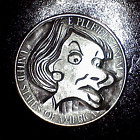
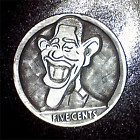
Myron Xenos Rightly Responds To Orosz
Responding to Joel Orosz' description of his near-tragedy with a shipment of numismatic books,
Leon Saryan writes:
The story about the water-drenched book shipment immediately recalled to my mind why I have invested a few dollars per year in a genuine post office box. I do not like anything of value to be delivered to my home directly. Joel should get himself a box at the Post Office.
Myron Xenos responds to Joel thusly:
Your missive in the E-Sylum LEFT me breathless. I am so glad that David used LIBERAL packing material to pack your books. He has always been careful and CONSERVATIVE about shipping. Thank God (oops) that your books arrived all RIGHT, and that there was only a MODERATE amount of precipitation. John Bergman was always a bit RADICAL in his methods, and I learned much from him, he was so PROGRESSIVE. I PALIN comparison to him.
Hopefully our Constitution is as well-packed as your books, so it doesn't get too watered down. David is a FOX when it comes to hunting down good packing material. I hope I'll be CNN you in Chicago. It was fun RIGHTing to you.
To read the earlier E-Sylum article, see: USPS BOOK SHIPMENTS: THE WHOLE DAMP STORY (www.coinbooks.org/esylum_v14n13a10.html)
THE BOOK BAZARRE
THOUGHTS ON THE SAN FRANCISCO MINT GOLD DELIVERY BOOK
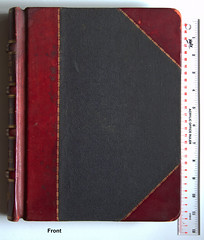
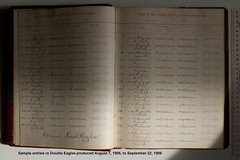
Regarding the San Francisco Mint ledger discussed last week, Ron Lerch writes:
I would worry greatly about having or offering this ledger. The government is currently operating with a right of replevin (reclaiming ownership) of any previously owned document, ledger, etc., regardless of the manner in which it was disposed. This applies on the state and federal level. It has already resulted in a number of items in California being reclaimed by the state after having been discarded at one time. It is causing great consternation among the dealers and collectors of historic Americana.
To read the earlier E-Sylum article, see: SAN FRANCISCO MINT GOLD DELIVERY BOOK OFFERED (www.coinbooks.org/esylum_v14n13a09.html)
WAYNE'S NUMISMATIC DIARY: APRIL 1, 2011
No foolin' - here's what I did on Friday, April Fool's Day. I left work a little early and headed north to Baltimore. I'd arranged to meet Joel Orosz and Len Augsburger at their table at the Whitman Coin Expo. Navigation was surprisingly easy. I parked at the Pier V public parking garage and walked back along Pratt street to the Baltimore Convention Center. Arriving at the convention center I rushed to register. The "Fill out your form here" table was completely empty - no forms there. I turned around and saw the registration booths. No one in line and a couple of people manning it. But they were already packed up for the day and had to rummage through boxes to find a form for me. I quickly filled it out and slapped my nametag on.
I rushed across the lobby to get to the door of the bourse. "I'm sorry, Sir, but you can't get back in - one-way traffic," said the security guard. It was 5:31. "But I haven't even been IN yet - I just registered!" No luck - I was hosed. I had been hoping to go in and razz John Burns at his numismatic literature table before heading over to the Whitman booth, where Len and Joel were signing copies of their newly-released"Secret History of the First U.S. Mint."
Rules are rules, but it was galling to sit there in the lobby staring at a sign announcing that the show closes at 6:00. By then it was 5:33. In the retail world, closing time is when one-way traffic starts. Oh, well. I decided to cool my heels in the lobby and see who I knew. Almost as on cue, out of the bourse walked Julian Leidman. I guess I shouldn't have been surprised - he was the first friend I ran into the last time I went to a Baltimore show. He's everywhere! The only other person I recognized was Ted Shiff of Cybercoins in Pittsburgh. We talked for a few minutes about the upcoming American Numismatic Association show in Pittsburgh. There may well have been other folks I knew in the lobby, but I only know most E-Sylum subscribers by name and email account, not by face.
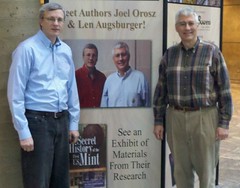 I had called Joel on his cell phone to let them know of my predicament. They were unable to leave their booth until closing time. Shortly after six, Joel, Len and his wife Deb walked out to greet me. It was fun catching up. Deb and I had the same idea - "Let's get a picture of these guys in front of the big sign for their book." Here's one I took. Below is another shot, where we got a little more creative.
I had called Joel on his cell phone to let them know of my predicament. They were unable to leave their booth until closing time. Shortly after six, Joel, Len and his wife Deb walked out to greet me. It was fun catching up. Deb and I had the same idea - "Let's get a picture of these guys in front of the big sign for their book." Here's one I took. Below is another shot, where we got a little more creative.
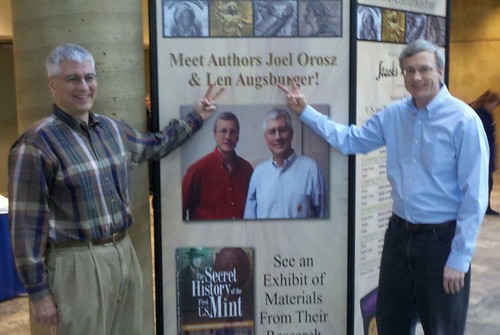
We wandered out into the cold street toward a restaurant. Deb guided us to Sullivan's Steakhouse. The place was busy, but luckily they had a table for four in a private room with a view of the street. There was a larger table in the room, but no party was seated there and we had the place to ourselves. Good thing - after the liquor was served, we got a little noisy.
First off, I want to publicly thank Joel and Len for picking up my meal. My remuneration for editing The E-Sylum is basically lunch money a few times a week, and we're talking burritos, not steaks. When I'm out with my family it's usually family fare at family-style chain restaurants. I told everyone I felt like I was getting to sit at the adult table at Thanksgiving dinner. Dinner won't be enough to get them a glowing review of their book (which we all joked about), but from what I've seen so far, a bribe will be unnecessary. The regular edition has been selling like hotcakes and as of Friday all but seven copies of the deluxe editions had been sold.
Conversation topics were all over the map, from research for the book to work and home life. I recounted my experience at the famous "Invasion of Louisville" where I met bibliophile Armand Champa, John Ford, Jules Reiver, Ken Lowe, Myron Xenos and a host of other numismatic luminaries and bibliophiles. Talk of Armand led to the infamous "Giant Meatball" story, a prank Armand pulled on John Burns during one of our visits to his home. I wrote it up for the Money tree's Out on a Limb.
Joel told a story about a day I'd almost forgotten about. Back in 2004 when I was the General Chairman for the Pittsburgh ANA Convention, I went out to lunch with Joel one day. I was wearing the big chairman's medal given to me by the ANA. Halfway through lunch the clasp gave way and my medal hit the floor and rolled away. Joel and I both wish we had a picture of the expression on my face. I retrieved the medal and we walked over to The Coin Exchange to buy a sturdier clasp.
I'd brought with me my contributor's copy of their book, which Len and Joel kindly signed for me. I also lugged along a large binder with my collection of numismatic prospectuses, including a flyer announcing the publication of Frank Stewart's book on the U.S. Mint. With Len's help, I expect to exhibit several of these neat pieces of numismatic ephemera at this summer's American Numismatic Association convention.
We weren't the only numismatists at the restaurant. Miles Standish of PCGS was in the main dining room, and paid for our table's desserts. Thanks! (mine was a yummy New York cheesecake). Later, a friend of Len's from the Liberty Seated Collector's Club joined us. I forgot to ask his OK to publish his name, so I can't, but it was a pleasure to talk numismatics with him.
Where did the time go? All of a sudden it was 10pm, and I still had a long drive home ahead of me. We said our goodbyes and off I headed to my car. Well actually, I walked half a block in the wrong direction as first, but I figured it out. I guess those wine glasses were bigger than they looked. The brisk walk cleared my head and I made it home by 11:30. It had been a wonderful evening of numismatic fellowship, and hopefully we'll be able to get together another time.
DO THESE LEAD CODICES HAVE A NUMISMATIC CONNECTION?
I do want to highlight a comment by Stephen B-C. in our previous post on this. He astutely notes the resemblance between coin portraits of Alexander the Great and some of the images attached to Peter Thonemann's letter at Dan McClellan's blog. I think Stephen B-C is bang on in his commentary. To supplement his analysis, I might note that the (date?) palms which seem omnipresent on all the images that are so far available (some in the new coverage which we will be getting to) are also very reminiscent of palm depictions on coins from Israel in the general period (I don't think there is an Alexander coin which also has a palm tree, by the way, but I might be mistaken about that). I'm willing to bet that as more images emerge, more ‘coin connections' will be able to be made.
To read the original blog post, see: Lead Codices – Once More into the ‘Reach' (rogueclassicism.com/2011/04/03/lead-codices-once-more-into-the-reach/)
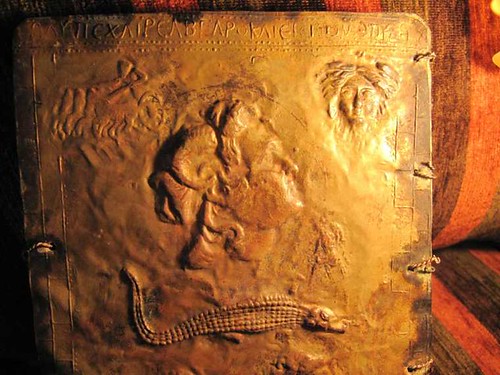
The Greek text at the top of your photo no. 0556 reads: ΛΛΥΠΕΧΛΙΡΕΛΒΓΛΡΟΚΛΙΕΙΣΙΩΝ, followed by ΛΛΥΠΕ in mirror-writing.
This text corresponds to ΛΛΥΠΕ ΧΛΙΡΕ ΛΒΓΛΡ Ο ΚΛΙ ΕΙΣΙΩΝ, i.e. ἄλυπε χαῖρε, Ἀβγαρ ὁ καὶ Εἰσίων, followed by the word ἄλυπε again, in mirror writing. The text at the bottom of your photo no. 0532 is the first part of the same text again: ΛΥΠΕΧΛΙΡΕΛΒΓ, i.e. [ἄ]λυπε χαῖρε, Ἀβγ…
The text was incised by someone who did not know the Greek language, since he does not distinguish between the letters lambda and alpha: both are simply represented, in each of the texts, by the shape Λ.
The text literally means ‘without grief, farewell! Abgar also known as Eision'. This text, in isolation, is meaningless.
However, this text corresponds precisely to line 2 of the Greek text of a bilingual Aramaic/Greek inscription published by J.T. Milik, Syria 35 (1958) 243-6 no.6 (SEG 20, 494), and republished in P.-L. Gatier, Inscriptions grecques et latines de Syrie XXI: Inscriptions de la Jordanie, 2: Region centrale (Paris 1986), no.118. That inscription reads, in its entirety, as follows,
1 Σελαμαν χρηστὲ καὶ 2 ἄλυπε χαῖρε, Ἀβγαρ ὁ καὶ Εἰσίων 3 Μονοαθου υἱὸς υἱῷ τειμίῳ τὸ μνῆμα 4 ἐποίησεν ἔτους τρίτου ἐπαρχείας
'For Selaman, excellent and harmless man, farewell! Abgar, also known as Eision, son of Monoathos, constructed this tomb for his excellent son (i.e. Selaman), in the third year of the province'.
This is a stone tombstone from Madaba in Jordan, precisely dated to AD 108/9, on display in the Archaeological Museum in Amman.
The text on your bronze tablet, therefore, makes no sense in its own right, but has been extracted unintelligently from another longer text (as if it were inscribed with the words: ‘t to be that is the question wheth'). The longer text from which it derives is a perfectly ordinary tombstone from Madaba in Jordan which happens to have been on display in the Amman museum for the past fifty years or so. The text on your bronze tablet is repeated, in part, in three different places, meaningless in each case.
The only possible explanation is that the text on the bronze tablet was copied directly from the inscription in the museum at Amman by someone who did not understand the meaning of the text of the inscription, but was simply looking for a plausible-looking sequence of Greek letters to copy. He copied that sequence three times, in each case mixing up the letters alpha and lambda.
This particular bronze tablet is, therefore, a modern forgery, produced in Jordan within the last fifty years. I would stake my career on it.
To read the original blog post, see: Peter Thonemann on the Lead Codices (danielomcclellan.wordpress.com/2011/03/31/peter-thonemann-on-the-lead-codices/)
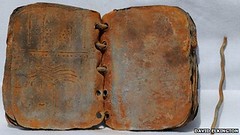 They could be the earliest Christian writing in existence, surviving almost 2,000 years in a Jordanian cave. They could, just possibly, change our understanding of how Jesus was crucified and resurrected, and how Christianity was born.
They could be the earliest Christian writing in existence, surviving almost 2,000 years in a Jordanian cave. They could, just possibly, change our understanding of how Jesus was crucified and resurrected, and how Christianity was born.
A group of 70 or so "books", each with between five and 15 lead leaves bound by lead rings, was apparently discovered in a remote arid valley in northern Jordan somewhere between 2005 and 2007.
The Israeli Bedouin who currently holds the books has denied smuggling them out of Jordan, and claims they have been in his family for 100 years.
Jordan says it will "exert all efforts at every level" to get the relics repatriated.
The books, or "codices", were apparently cast in lead, before being bound by lead rings.
Their leaves - which are mostly about the size of a credit card - contain text in Ancient Hebrew, most of which is in code.
If the relics are of early Christian origin rather than Jewish, then they are of huge significance.
One of the few people to see the collection is David Elkington, a scholar of ancient religious archaeology who is heading a British team trying to get the lead books safely into a Jordanian museum.
He says they could be "the major discovery of Christian history", adding: "It's a breathtaking thought that we have held these objects that might have been held by the early saints of the Church."
He believes the most telling evidence for an early Christian origin lies in the images decorating the covers of the books and some of the pages of those which have so far been opened.
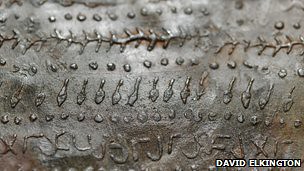
Mr Elkington says the relics feature signs that early Christians would have interpreted as indicating Jesus, shown side-by-side with others they would have regarded as representing the presence of God.
"It's talking about the coming of the messiah," he says.
Arthur Shippee writes:
Several news sources have been reporting a new "find" and making strong claims for its potential significance. David Meadows' blog posts give links to the media coverage, and to many scholarly opinions that are appearing on academic blogs. The finds are small lead plates, bound together as a codex (i.e., book), inscribed with various symbols and letters, part in Greek and part in the Hebrew script of the time. The codex form was used by early Christians, instead of the roll, and such a thing is mentioned in the Book of Revelation.
The suggested claim is that these codices are perhaps mid-first century Christian texts, providing the earliest evidence for Christian beliefs and practices. At present, suspicion is aimed at various points. There are two separate people somehow involved with the "discovery," an Englishman and an Israeli Bedouin. Neither is a scholar, both have, let's say, interesting backgrounds. Their stories, as described by Meadows, are conflicting; also, new "evidence" coming out seems tailored to meet emerging scholarly challenges. Furthermore, the iconography seems to borrow from known coins (hence my alerting Wayne), and the Greek text of one sheet is a mangled form of a known inscription (v.i.).
Given the market for Hebrew and early Jewish antiquities, there is a great increase in the number and sophistication of forgeries, and also in the hype surrounding relatively minor finds (e.g., the so-called Gospel of Judas). The way this is being "reported" and handled suggests to some that this is another case of either a forgery or something that will prove trivial or irrelevant. The story is mainly interesting as an example of people trying to manipulate scholarship for non-scholarly gain. Whether there's anything more here, we'll see, but no one who has worked with the Qumran finds or Nag Hammadi finds (both surprises and real) or with the many phony or over-hyped finds is expecting much from this
To read the original article, see: Jordan battles to regain 'priceless' Christian relics (www.bbc.co.uk/news/world-middle-east-12888421)
HOW THE INTERNET HAS CHANGED RARE COIN AUCTIONS
The impact of the internet on coin auctions in the past ten years has been monumental; more so, I'd venture to say, than virtually any other collectible. Ten years ago, the auction business had a number of vital firms offering coins; today it is essentially a duopoly. Ten years ago, auctions were primarily a place where dealers battled against each other in a sort of numismatic bloodsport; today, they are kinder and gentler. Most importantly, the numbers have grown beyond what I would have ever expected. It is now commonplace for an auction to realize $40-50 million; a decade ago this would have been startling, front-page-of-Coin World news.
The fact that everybody now uses fast computers is compounded by portability of these machines. Ten years ago, a collector might panic when he realized that an auction he cared about was the same time as his family's spring break trip to Florida. With laptops and iPads, your location is almost meaningless. This makes participation is an auction easier than ever as does, of course, the increased memory of today's computers.
For me, the greatest coin sales of all time were the Bass auctions, held in 1999 to 2001. I can remember at the Bass II sale (to me, the single most memorable of the four sales) there were less than a dozen collectors in the auction room participating. And, of course, no internet and probably not much mail or phone bidding. Today, a sale of this magnitude would attract hundreds of well-heeled collectors from all over the world. The internet has made coin auctions so much more accessible and, as a result, they are now so much more collector-dominated.
Transparency is the numismatic buzzword of this decade; sort of like "green" is to consumer products. Ten years ago, the thought of transparency made numismatic auction firms recoil in horror. Only Heritage was smart enough to realize that by being transparent they would gain the trust of their clients and, in turn, do more business. The lack of transparency (and the failure to embrace technology early on) was one of the main things that did in Heritage's largest rivals in the coin auction business.
The coin auction business is now built on a platform that is far more transparent than other collectibles. This has had an impact on both collectors and dealers. In the past, a dealer could buy a coin from an auction, mark it up (or upgrade it) and offer it for sale, often with the potential buyer having no idea where it was from. Now, most coins in dealer's inventories can be easily traced to auctions. If a dealer offers a coin for $8,000 that just sold at a Heritage sale for $5,000, it might greatly offend a potential client. Margins, for internet-savvy buyers, tend to be smaller as a result.
This access to information has put the collector on much more level playing field than ever before. Even a new collector can see what coins bring at auction and now have a degree of comfort knowing that there is (hopefully) a legitimate under-bidder at 5-10% less than what they just paid.
To me, the existence of such huge databases as the Heritage auction archives and the PCGS auction prices realized archives are incredibly valuable. Ten years ago, I had my own databases for most branch mint gold but this was a ton of work. Now, someone else does the work for me and, frankly, they do it better. The amount of information available to collectors has leveled the playing field; not always the best thing for me as a dealer but certainly a great thing for the collector. Actually, let me correct myself. It probably, in the long run, is great for me as a dealer…
To read the complete article, see: How the Internet Has Changed Rare Coin Auctions (www.raregoldcoins.com/market-blog/how-the-internet-has-changed-rare-coin-auctions)
BIRMINGHAM MINT RELOCATES
The relocation of the Birmingham Mint to Kidderminster brings to an end 200 years of an association with the city.
The Mint claims to be the world's oldest and has had a colourful history since it started production in 1794.
It went into administration in 2003 and was forced to close its doors before being revived, initially, as a working museum.
The Mint has turned out currencies for more than 100 governments as well as many Royal and military medals.
The production of tens of thousands of coins, as well as jewellery, now continues in at the Mint's new premises in Kidderminster.
As well as coins, the Mint's portfolio over the years has included the manufacture of hundreds of military awards, including National Service medals.
They have also made medals for the Professional Footballers' Association and were the official suppliers to the London Marathon for more than a decade.
Hundreds of blank Euro coins were also produced, predominately for the Netherlands and Spain, when the currency was first adopted in 2002.
That same year, the Mint produced commemorative medals of the Queen's golden jubilee and, this year, is producing around 50,000 coins to mark the wedding of Prince William and Kate Middleton on 29 April.
To read the complete article, see: Birmingham Mint: A brief history (www.bbc.co.uk/news/uk-england-birmingham-12921424)
MOVIE LAWYER DISCUSSES PROP CURRENCY
Q: I've heard that it is illegal to use U.S. currency in films, though I have seen it in films before. I've been using money facsimiles for photography. Though the money looks real, it is watermarked on both sides with a disclaimer saying "not for legal tender." I am about to shoot a film that requires cash props and wondered if the bills I have break any regulations.
David Albert Pierce, Esq.: Your belief that you cannot film money is incorrect. A law permitting the filming of cash for use in motion pictures is found in the U.S. Code under the topic heading, "Printing and Filming of United States and Foreign Obligations & Securities" (18 USC 504), and it reads as follows: "Notwithstanding any other provision of this chapter, the following are permitted: . . . (3) The making or importation of motion-picture films . . . for projection upon a screen or for use in telecasting of postage and revenue stamps and other obligations and securities of the United States, and postage and revenue stamps, notes, bonds, and other obligations or securities of any foreign government, bank, or corporation."
As for your creation of your own "prop money," you should be aware that you are actually better off using actual money in your motion picture. If you desire to use "prop money" then you must fully comply with the requirement of "The Counterfeit Detection Act of 1992" (31 CFR 411). The applicable portion of that law states that when creating prop money, the requirements of 31 CFR § 411.1(a) must be met, which reads, ". . . authority is hereby given for the printing . . .or making . . .of the necessary plates or items for such printing or publishing, of color illustrations of U.S. currency provided that:
(1) The illustration be of a size less than three-fourths or more than one and one-half, in linear dimension (of actual U.S. currency), of each part of any matter so illustrated;
(2) The illustration be one-sided; and
(3) All negatives, plates, positives, digitized storage medium, graphic files, magnetic medium, optical storage devices, and any other thing used in the making of the illustration that contain an image of the illustration or any part thereof shall be destroyed and/or deleted or erased after their final use in accordance with this section."
Given the strict requirements of the "Counterfeit Detection Act" it's usually easier to use real money, assuming you can get your hands on the type of cash you want to use for the scene (which might be difficult if the scene requires the use of hundred dollar bills). However if, for example, you plan to burn cash, then you will need to use prop money and follow the rules of "The Counterfeit Detection Act" which requires the bills to be smaller than actual bills, one sided and destroyed after their intended use. Burning actual currency is a crime set forth under 18 USC 333, which prohibits burning money or mutilating currency in any way so as to render it unfit to be reissued.
To read the complete article, see:
Cinema Law: Can I Film U.S. Currency?
(www.moviemaker.com/blog/item/cinema_law_filming_money_
united_states_currency_20110125/)
HOW THE BRAIN RESPONDS TO THE DESTRUCTION OF MONEY
 The study is called How the Brain Responds to the Destruction of Money. It tells how the brains of 20 Danish persons, all of them adults with no history of psychiatric or neurological disease, responded as they watched videos of somebody destroying lots of Danish money.
The study is called How the Brain Responds to the Destruction of Money. It tells how the brains of 20 Danish persons, all of them adults with no history of psychiatric or neurological disease, responded as they watched videos of somebody destroying lots of Danish money.
This neuroscience research was performed by Uta Frith and Chris Frith of University College London, together with Joshua Skewes, Torben Lund and Andreas Roepstorff of Aarhus University, Denmark, and Cristina Becchio of the University of Turin, Italy.
Here, in the scientists' words, is what the volunteers saw: "A series of videos in which different actions were performed on actual banknotes with a value of either of 100 kroner (approximately 13 euro/$18) or 500 kroner (approximately 67 euro/$91), or on valueless pieces of paper of the same size ... We contrasted actions that were appropriate to money (folding or looking at valuable notes or valueless paper) and actions that were inappropriate (tearing or cutting notes or paper)."
The Danes had their heads inside a functional magnetic resonance imaging scanner (fMRI), which recorded their brain activity. The researchers also asked each volunteer some questions, including, "How did it make you feel?" All of this, says the document, "confirmed that participants felt less comfortable during observation of destroying actions performed on money".
An additional finding: the volunteers felt more "aroused" when watching anything happen to money than when watching the same things happen to worthless paper.
They note the existence of published studies that "suggest that money can also act as a drug".
To read the complete article, see: How the Brain Responds to the Destruction of Money (www.guardian.co.uk/education/2011/mar/28/how-brain-responds-when-money-destroyed)
SCRAPPED EURO COIN SMUGGLING RING FOILED IN GERMANY
Loren writes:
Here's a link to an article about recently discovered scam involving one and two Euro coins. For once, the Chinese are not counterfeiting coins--they are merely putting them back together! Nice work if you can get it...
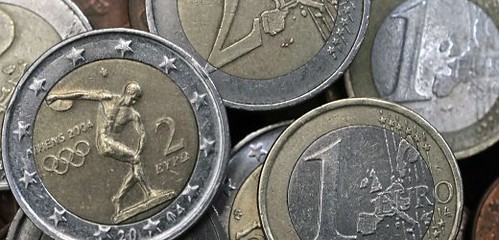
German prosecutors have uncovered a 6 million euro scam involving reconstituted euro coins that had been sold to China as scrap metal. One and two euro coins were then brought back to Germany, some via Lufthansa airline employees, and traded in at the central bank.
German investigators say they have discovered a massive scandal involving the reintroduction of euro coins that had been taken out of circulation and sold as scrap to China. The scheme, said to have cost Germany's Central Bank €6 million ($8.5 million), involved airline employees -- including Lufthansa flight attendants.
On Wednesday, authorities searched homes, businesses and offices, including those belonging to Lufthansa workers. Six people were arrested, according to public prosecutors in Frankfurt.
The scam was not complicated. Every year, tons of damaged euro coins are taken out of circulation, "destroyed," and then sold as scrap metal. Often, however, one and two euro coins are merely separated into their component parts -- the inner core are outer rings -- prior to delivery to scrap metal dealers in China.
A group in China would simply reassemble the coins. The criminals paid four airline employees, who have no weight restrictions on their baggage, to ferry the money back to Germany. They then took the coins to the Bundesbank and exchanged them for cash.
Authorities estimate the group was able to exchange 29 tons of reconstituted coins between 2007 and 2010. In raids on Wednesday, officials seized laptops, documents and a machine for pressing coins together.
According to the German tabloid Bild, the scam was only uncovered after a customs officer noticed an airline flight attendant struggling with heavy luggage. When it was opened, officials found thousands of €1 and €2 coins inside, Bild reported.
To read the complete article, see: Scrapped Euro Coin Scam Costs Bundesbank Millions (www.spiegel.de/international/germany/0,1518,754238,00.html)
Four flight attendants, "who have no weight limits on their luggage," are among those suspected of taking part in the scheme by carting the reassembled coins back to Germany, Moeller-Scheu said.
Four of the six people detained following a sting Wednesday in the Frankfurt region were immigrants from China, Moeller-Scheu said in a statement. No employees of the Bundesbank were among the suspects, she said.
To read the complete article, see: Germans arrest 6 in euro coin racket (news.yahoo.com/s/ap/20110331/ap_on_bi_ge/eu_germany_euro_coin_racket)
FEATURED WEB PAGE: 1792 HALF DISME DUG UP IN VIRGINIA
This week's Featured Web Page is a 2006 page from a treasure hunter's web forum picturing a 1792 Disme found with a metal detector.Today was the highlight of my 22 years of detecting. My buddy Dale and I went relic hunting today. We hit a nice cleared site and began finding both union and confederate relics. After awhile I got a signal that hit like a bullet on my Explorer. I was surprised to see a silver coin in my dirt pile. At first I thought I had dug a Spanish silver but after looking more closely I knew I had something very rare. A couple years ago I dug a 1916 D Mercury dime but that doesn't compare to this 1792 Half Disme. This is a day I will never forget nor will ever top.
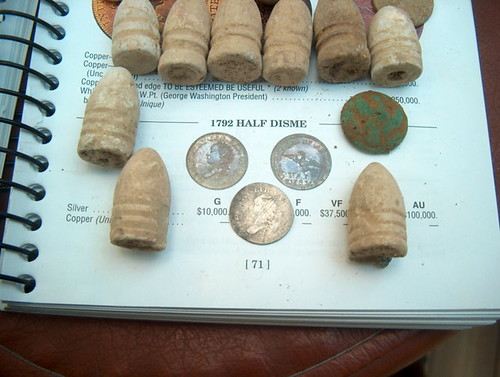
forum.treasurenet.com/index.php/topic,54406.0.html
